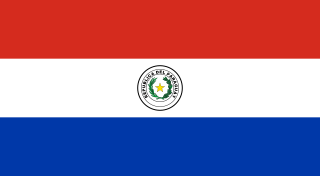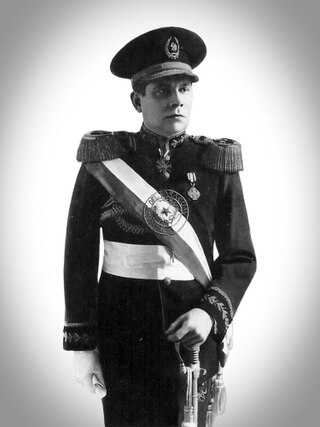
Paraguay, officially the Republic of Paraguay, is a landlocked country in South America. It is bordered by Argentina to the south and southwest, Brazil to the east and northeast, and Bolivia to the northwest. It has a population of around 6.1 million, nearly 2.3 million of whom live in the capital and largest city of Asunción, and its surrounding metro area.

Alfredo Stroessner Matiauda was a Paraguayan army officer, politician, statesman, and President of Paraguay from 15 August 1954 to 3 February 1989. Stroessner led a coup d'état on 4 May 1954 with the support of the army and the Colorado Party, with which he was affiliated. After a brief provisional government headed by Tomás Romero Pereira, he was the Colorado Party's presidential candidate for the 1954 general election, and was elected unopposed since all other parties were banned from 1947 to 1962.

Andrés Rodríguez Pedotti was a military officer and politician, being President of Paraguay from February 3, 1989, to August 15, 1993. He led the coup d'état on February 2 and 3, 1989, against the dictator Alfredo Stroessner Matiauda.

Óscar Nicanor Duarte Frutos is a Paraguayan politician who served as President of Paraguay from 2003 to 2008. In 2013, President Horacio Cartes appointed Duarte as Ambassador to Argentina, a diplomatic posting he held from 2013 until 2016. Duarte currently holds the title of Senator for life.

The National Republican Association – Colorado Party is a conservative political party in Paraguay, founded on 11 September 1887 by Bernardino Caballero. Since 1947, the Colorado party has been dominant in Paraguayan politics, ruling as the only legal party between 1947 and 1962, and has controlled the presidency since 1948 notwithstanding a brief interruption between 2008 and 2013. With almost 2 million members, it is the largest political party in the country.

Higinio Nicolás Morínigo Martínez was a Paraguayan military officer, politician and statesman who was as a prominent officer of the Paraguayan Army during the Chaco War (1932–1935) and later served as President of Paraguay from September 7, 1940 until his overthrow on June 3, 1948.

The Authentic Radical Liberal Party is a centre-left liberal and radical political party in Paraguay. The party is a full member of Liberal International. The liberales, as they are known, are the leading opposition to the dominant conservative Colorado Party. They have taken this position since the end of the Alfredo Stroessner dictatorship in 1989. They are the political successors of the Liberal Party, which traces its history back to 10 July 1887.
The Paraguayan Civil War was a civil war in Paraguay that lasted from 7 March to 20 August 1947.

Juan Natalicio González Paredes was a Paraguayan politician and poet who served as President of Paraguay from 15 August 1948 to 30 January 1949.
Pastor Milciades Coronel was the chief of the Investigations Department during General Alfredo Stroessner's dictatorship of Paraguay. He is considered by human rights activists, like Martín Almada, to be the most feared torturer of the dictatorship. The discovery of the "Archives of Terror" showed that he was the perpetrator of several human rights violations.
Agustín Goiburú was a politician from Paraguay. He was the leader of the movement MOPOCO that represented the strongest opposition to the dictatorship of Alfredo Stroessner. He was murdered during the Operation Condor. He was a doctor, specialized in orthopedic surgery in Brazil. When he returned to the country, he worked in the Social Prevention Institute and in the Police Policlinic “Rigoberto Caballero”.
The Painful Easter is the name given by the Paraguayan press to the repression of several farmers groups accused of participating in the clandestine movement Organización Primero de Marzo (OPM) by the police of the Alfredo Stroessner regime. The persecution reached many regions of the country and destroyed any attempt of building any kind of organization between agriculture workers.
Epifanio Méndez Fleitas was a Paraguayan politician, musician, writer and poet, and twice the president of Central Bank of Paraguay: from 1952 to 1954 and in 1955. He fled Paraguay during the Alfredo Stroessner years and was the uncle to future President Fernando Lugo. He died in Buenos Aires.

The dictatorship of Alfredo Stroessner, colloquially known as El Stronismo or El Stronato, was the period of almost 35 years in the history of Paraguay in which army general Alfredo Stroessner ruled the country as a de facto one-party state under an authoritarian military dictatorship, from 15 August 1954 to 3 February 1989.
Edgar Linneo Ynsfrán Doldán was a Paraguayan politician who held important governmental posts during the dictatorship of Alfredo Stroessner. He became Minister of the Interior in Paraguay in 1956, and held key roles in the severe political repressions of the late 50s and early 60s in the country. He was dismissed from his post in 1966 and retired from politics until the mid-1980s, when he emerged as one of the leaders of the anti-Stroessner movement within the military and the Colorado Party.
The term Cuatrinomio de Oro refers to a group of influential Paraguayan politicians of the 1960-1980s, representing the closest allies of the dictatorial President Alfredo Stroessner. The group included three members of the government and the presidential secretary. Under the leadership of Stroessner, members of the "Golden Four" stood at the highest levels of the regime, determining the policy of the state and the Colorado Party. They became infamous in the country due to their involvement in political repression and corruption. After the fall of the regime, they were prosecuted.
Juan Manuel Frutos Fleitas was a Paraguayan politician and government minister under the dictatorship of Alfredo Stroessner. He was the founder and first chairman of the Rural Welfare Institute, and as such, he was one of the key figures of the Stroessner administration's economic policy, spearheading the "March to the East" land reclamation and colonization project of the 1960s-1980s. Frutos, a staunch anti-communist, also served as an ideologue of the Stroessner regime, and was the chairman of the Paraguayan branch of the World League for Freedom and Democracy anti-communist organization.

The Guión Rojo was a Paraguayan paramilitary organization of the 1930-1950s, which was formed in 1942 as the paramilitary wing of the Colorado Party. It united supporters of Colorado leader Juan Natalicio González, far-right nationalists, anti-communists and adherents of Falangist and pro-fascist ideas. It played a prominent role under the dictatorial regime of the 1940s, in the civil war of 1947, the subsequent political struggle and the establishment of Alfredo Stroessner's dictatorship.
Antonio Campos Alum was a Paraguayan politician and head of the National Directorate of Technical Affairs, a law enforcement agency during the dictatorship of Alfredo Stroessner.
Ramón Aquino was a Paraguayan far-right politician from the Colorado Party, known as the leader of the Garroteros militia during the dictatorship of Alfredo Stroessner.










